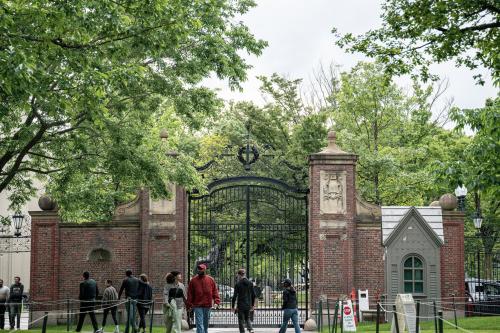This is a summary of an event held on December 11, 2024; click here to view the video.
On December 11, Brookings Senior Fellow Sarah Reber presented her new report “Supporting students to and through college: What does the evidence say?” to an audience at the Brookings Institution. The event, hosted by the Center for Economic Security and Opportunity (CESO), included a short presentation by Reber that summarized the report’s findings, a panel featuring higher education experts and moderated by Brookings Fellow Katharine Meyer, and finally, questions from the audience. Panelists included Reber; Ben Castleman, associate professor in the economics of education at University of Virginia and founder of Nudge4 Solutions Lab; Michelle Dimino, director of education at the D.C. think tank Third Way; and Shun Robertson, senior vice president at the University of North Carolina (UNC) system.
Opening the event, Reber’s presentation highlighted that as evidence continues to support high returns to higher education, addressing college access and completion is a key policy area. Reber notes in the report that disparities in high school preparedness lead to uneven college access and completion rates, which are exacerbated by a students’ socioeconomic status. As a result, these students may face difficulties with preparedness in the classroom which are often compounded by financial and personal challenges at home. Reber’s report serves as a long-form summary and analysis of interventions that have been evaluated with the goal of increasing college enrollment and graduation rates to alleviate such disparities.
Reber divides these interventions into three categories—advisors and navigators, comprehensive programs, and low-touch—and finds that the category with the most promising results is comprehensive programs. Based on her review of the interventions, Reber highlighted three lessons from the report in her presentation:
- First, institutions should focus on what they can do well and sustain. While comprehensive programs may be most effective, they are also relatively expensive, which makes them difficult to sustain.
- Second, inducing students into more selective institutions is a promising strategy for increasing completion rates, but this is only possible if high-quality, affordable options are available.
- Third, the effectiveness of FAFSA information and support interventions is limited by the complexity of the process itself. Students need to know about their financial aid options before they even apply to colleges.
Reber also discussed areas where she believes more research is needed, including how to best encourage students to use support services, barriers to simplification, the role of faculty, how programs can affect students’ long-term outcomes, and measuring the value of credits that don’t lead to a credential. She concluded the presentation with the argument that while structural problems will limit progress, evidence suggests that incremental improvements are very possible and there is a wide range of existing research to draw from in future work.
During the panel, Robertson found that Reber’s point on simplification particularly resonated with some of the programs that the UNC system was conducting to make the application and financial aid process smoother for high schoolers in North Carolina. Throughout the panel, Robertson referred back to transfer students as a target group for enrollment interventions and emphasized that early notification is paramount for students to successfully transfer from community college to a four-year program.
Dimino emphasized Reber’s discussion of program sustainability, and broadened the scope to include financial resources, administrative and staffing capabilities, and state legislative support.
Castleman, who has conducted extensive research on the use of nudges to shape students’ actions and improve completion rates, made the point that the successful information programs are those that send information to students from someone that they already have a personal relationship with, such as an involved advisor. He argued that the interventions that are most promising are those that set up or encourage sustained human relationships between students and their advisors or mentors.
Themes in the rest of the panel included the implementation and replication of interventions at institutions, the role of the federal government, the tradeoffs between efficacy and scale of programs, setting quality standards for underperforming colleges, and student displacement from selective institutions.
To hear more discussion on the report and the future of higher education research, watch the recording of the event here.
-
Acknowledgements and disclosures
The Brookings Institution is financed through the support of a diverse array of foundations, corporations, governments, individuals, as well as an endowment. A list of donors can be found in our annual reports, published online. The findings, interpretations, and conclusions in this report are solely those of its author(s) and are not influenced by any donation.
The Brookings Institution is committed to quality, independence, and impact.
We are supported by a diverse array of funders. In line with our values and policies, each Brookings publication represents the sole views of its author(s).







Commentary
Perspectives on the future of higher education research
December 19, 2024